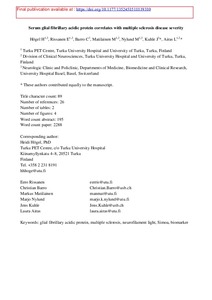Serum glial fibrillary acidic protein correlates with multiple sclerosis disease severity
Christian Barro; Markus Matilainen; Marjo Nylund; Heidi Högel; Laura Airas; Jens Kuhle; Eero Rissanen
https://urn.fi/URN:NBN:fi-fe2021042720538
Tiivistelmä
BACKGROUND::
Cerebrospinal fluid (CSF) levels of two soluble biomarkers, glial fibrillary acidic protein (GFAP) and neurofilament light chain (NfL), have been shown to associate with multiple sclerosis (MS) disease progression. Now, both biomarkers can be detected reliably in serum, and importantly, their serum levels correlate well with their CSF levels.
OBJECTIVE::
To evaluate the usability of serum GFAP measurement as a biomarker of progressive disease and disease severity in MS.
METHODS::
Clinical course, Expanded Disability Status Scale (EDSS), disease duration, patient age and magnetic resonance imaging (MRI) parameters were reviewed in 79 MS patients in this cross-sectional hospital-based study. Serum samples were collected for measurement of GFAP and NfL concentrations using single molecule array (Simoa) assay. A cohort of healthy controls was evaluated for comparison.
RESULTS::
Higher serum concentrations of both GFAP and NfL were associated with higher EDSS, older age, longer disease duration, progressive disease course and MRI pathology.
CONCLUSION::
Earlier studies have demonstrated that GFAP, unlike NfL, is not increased in association with acute focal inflammation-related nervous system damage. Our work suggests that GFAP serum level associates with disease progression in MS and could potentially serve as an easily measurable biomarker of central nervous system (CNS) pathology related to disease progression in MS.
Kokoelmat
- Rinnakkaistallenteet [19207]
